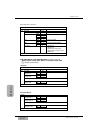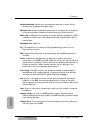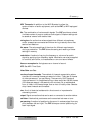
DA7 Users’ Guide
Glossary
Glossary-1
A/D converter. An electronic device that converts analog signals into digital
signals. D/A is the opposite, converting digital signals to analog.
AES/EBU. A specification using time division multiplex to send two channels
of digital audio data via twisted pair and using XLR connectors.
analog. A continuously varying electrical signal. Direct transformation of
sound or picture signal data into another form of electrical signal.
assign. To route or switch a signal to a particular or combination of signal
paths.
attenuator. An electronic device used to reduce the value of an electronic
signal. No attenuation results in maximum signal level. See fader and
level.
audio. What people listen to; pertaining to audible sound, the broadcasting
of sound, the reproduction of sound, and the sound portion of a
production.
automation. Computerized methods replacing manual operations. Based on
timecode, the DA7 automation system will memorize fader positions,
switch individual channels off and on, adjust equalization or pan
positions and change the auxiliary sends. The DA7 also allows you to
record an entire mixing session and then edit the individual channel
settings in multiple passes.
auxiliary send/auxiliary return/aux. The auxiliary send is used to feed
signals from the output channels to external devices such as effects
processors, amplifiers, or multi-track recording equipments. The auxiliary
return is used to receive output channels from external devices. The DA7
has six input sends and six output sends. Aux sends and returns are
usually only used with peripheral processors.
Glossary


















